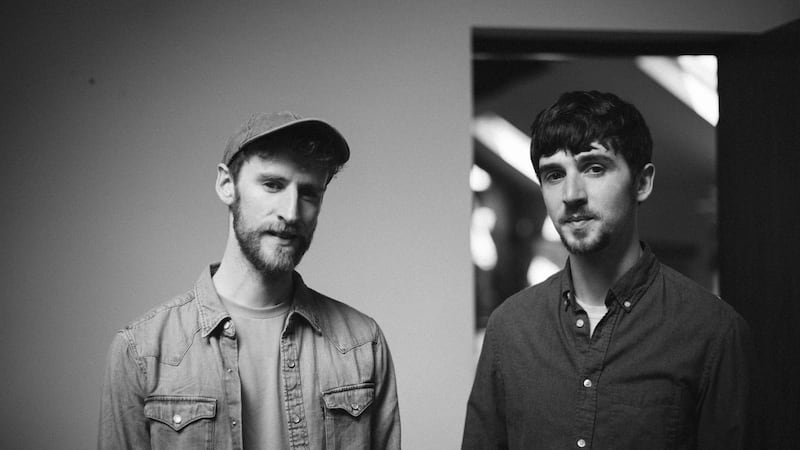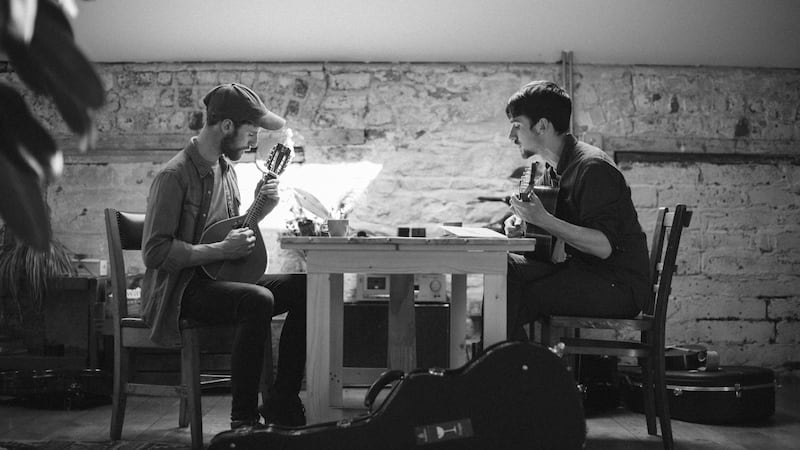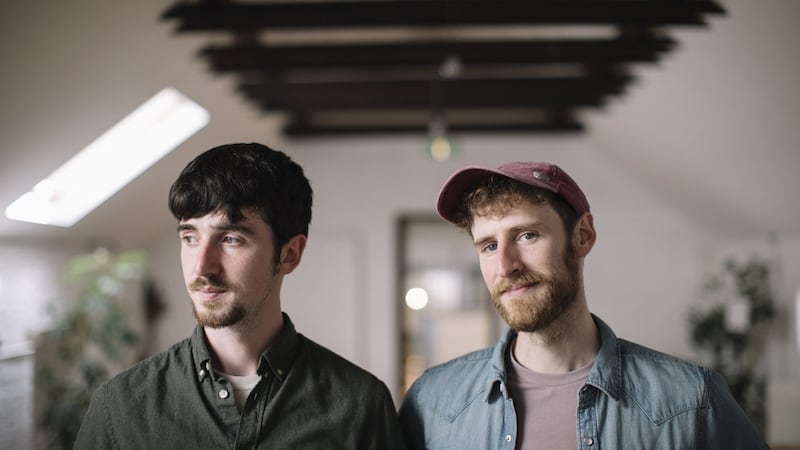Brían MacGloinn, one half of Ye Vagabonds, once heard an analogy about how individual folk artefacts fit into the wider tradition. “If you see a river flowing, it looks like a fixed piece of landscape. But actually it’s always moving. It’s always changing shape. And if you were to take a scoop out of it at any one point, you can say what’s in it right now, but that isn’t the river. It’s just a little bit of it.”
Ye Vagabonds, the MacGloinn brothers from Carlow with roots in Arranmore, Donegal, are about to release their beautiful third album, Nine Waves. That's their little bit of the river. They're talking to me via Zoom, Brían from Wicklow and Diarmuid from Stoneybatter in Dublin. Nowadays, they're embedded in the folk tradition. As teenagers they were more into rock music until they found themselves journeying from Led Zeppelin to Bert Jansch to Sweeney's Men. Why do they think so many Irish people follow a similarly convoluted path to trad? "I think Irish people weren't that proud of being Irish for a while and they may have been trying to reject a certain kind of Irish identity," says Brían.
"Pub singing belonged to the GAA clubs. . . and Ra supporters," says Diarmuid. "It was tied into nationalism. . . We didn't hate it, but it just didn't seem interesting to us. Our parents' taste in music was Cat Stevens to Mary Black and Planxty and a bit of Simon & Garfunkel. . . and they were into folk clubs. But it was our parents' music. . . When you're a teenager, you want to find your own thing."
The MacGloinns only started singing together when Brían was 16 and Diarmuid was 19. “Someone asked us to sing something and we sang in harmony together, just the two of us, for the first time,” says Diarmuid. “We realised that it was easy and nice and our voices blended well.” They started busking together. “Whatever we could pick up fast that was simple and had nice harmonies and we could play with a guitar and a fiddle or a mandolin.”
When we walked into the Night Before Larry Got Stretched, it was really exciting, hearing this high-quality, beautifully ornamented singing from young people...
A strong traditional folk scene was developing at that time – other acts such as Lankum and Lisa O'Neill – but the MacGloinns weren't aware of that initially. "I think the first time we went to a singing session it was the Night Before Larry Got Stretched [music session] in the Cobblestone and it was one of the first times that we saw how many of those people that there were," says Brían. "We just felt like we were total weirdos in Carlow."
Diarmuid laughs. “We definitely had people coming up in Carlow asking us ‘Why aren’t you playing Sex on Fire [by Kings of Leon]?’” he says. “When we walked into the Night Before Larry Got Stretched, it was really exciting, hearing this high-quality, beautifully ornamented singing from young people. . . And kind of terrifying as well, because suddenly we weren’t the only young folky people.”
Why do you think younger people were finding something in this music? "John Francis Flynn and Lankum and the lads from Skipper's Alley, all of us would have come out of school at a time when it wasn't possible to get a job," says Brían. "It was peak recession. I think that was part of it. We were all just hanging out and making this music. . . It was very much something that we did together in smoky dark kitchens late at night. . . It's easy music to share in those scenarios."
Old folk songs are frequently about the poor, marginalised and exiled but traditional music is also part of official culture in Ireland. The MacGloinns are aware of the tension between the two things, most notable in the fact that the artists used to sell Ireland can't always afford to live here. "The official culture thing, you really want to avoid some of that stuff because you can get trapped in a Bord Fáilte ad," says Diarmuid. "We did the stuff for Michael D [they played his second inauguration] because Michael D is really sound as far as politicians go. If you're an artist, there's no reason to dislike him. He's a good lad."

"There's this massive international greening project that goes on," says Brían. "It's the Department of Foreign Affairs. It's what they're all about. But it does ghettoise the music and it does restrict the way that people hear it. . . In the States and in Europe, people don't really hear the music in the same way. Even the songs that we write, they'll define as somehow being rooted in tradition, like they could have been written 200 years ago, when I don't necessarily hear them that way."
Ye Vagabonds are not purists. For Nine Waves they worked with Crash Ensemble string players Kate Ellis and Caimin Gilmore and noise rock producer John "Spud" Murphy (who also produced Lankum) to create eerie soundscapes on to which their more traditional playing fits. "To bring in other sounds from other worlds, it opens people's ears," says Brían.
The three original songs they recorded, An Island, Blue is the Eye and Go Away and Come Back Hither, they see as the emotional centrepiece of the record. “Blue is the Eye started as a lullaby,” says Brían. “The images were all drawn from one set of memories of an old friend of mine who died in the second lockdown. He was 88 or 89 when he died… I spent a lot of time with Andrew just talking to him about [renowned Arranmore singer] Róise Rua, talking to him about other songs on the island. . . He had a great memory and was an amazing storyteller and a hilarious character, brilliant at winding people up. . . He was the connection to an older generation on the island that I wanted to know more about.”
A lot of Ye Vagabonds' repertoire comes from trawling the archives. Before Covid they'd spend a day a week in the Irish Traditional Music Archive using the helpful archivists there as "an algorithm" that pointed them to interesting things. Diarmuid gives an example of a song on Nine Waves called Her Mantle So Green which he learned from a singer called Jim O'Neill. "I went away and slightly altered the melody. . . I felt like the lyrics were incomplete. . . some of the story wasn't particularly fully told. So I went hunting down other versions of the song."
There was no radio and no TV and no recorded music available at all in rural Ireland and if you had a song, that was a hugely valuable thing
Were there other versions? "Loads. There was PW Joyce manuscript. There were various other manuscripts, some taken from newspapers. They used to print ballads in newspapers. Then there were two friends of ours who had versions that had their own unique quirks, great singers: Micheál Quinn and Andreas Schultz. I kind of brought all those sources together and made a few little tweaks of my own."
There’s a puzzle-solving element to these quests, he says. “Sometimes you’ll have a song that captures your attention because there’s something obscure and weird about it that doesn’t make sense. And then it can be really satisfying when you’re looking for versions and you find a verse that unlocks the meaning of the whole song.”
Since the 1960s, it’s been a truism among rock fans that there’s something inauthentic about someone singing songs they didn’t write. But for singers in the folk tradition there’s power in singing something that’s been shaped by centuries of singing. “It’s like a diamond, each facet has been polished by the next generation,” says Diarmuid. “Academics who are interested in folk songs are particularly interested in finding the original version. . . But there are a number of songs where the original was [a song] nobody sings anymore, but there’s a later version of it that, because of the singers that picked it up and did their own thing with it, is more beautiful.”

Being able to collect and memorise songs was once a culturally important skill, says Brían. "There's a guy up in Arranmore called Johnny Duffy. He's my other 89-year-old friend. Johnny was saying how back when he was younger, people didn't have music. There was no radio and no TV and no recorded music available at all in rural Ireland and if you had a song, that was a hugely valuable thing. It held such social capital."
“People would go travelling to like the next town over if they heard someone had a new song they’d never heard,” says Diarmuid. “People would really go hunting for the songs because they were so valuable.”
Having grown up in Carlow town, coming through Carlow on the barge was like this heroic journey
For Ye Vagabonds, music is bound up in community, whether it’s an island community or a community of pub singers or a community of avant-garde musicians making a folk record or the community that forms between performers and audience. Last year they travelled the waterways of Ireland in a barge, playing gigs on the banksides along the way. “Having grown up in Carlow town, coming through Carlow on the barge was like this heroic journey,” says Diarmuid. “And, actually, we performed feats of heroism, various rescues.”
Seriously? “We got a call off one of the lock keepers at one point and they said, ‘Lads we need you up in Carlow as quick as possible, there’s another boat after getting stuck under Carlow bridge’,” says Brían. “It felt like Batman getting the call but going at four miles an hour.”

“The first rope actually snapped,” says Diarmuid. “We tied the second rope on and then we were driving at speed towards the weir, which is the last place you want to be going in your barge and just at the last minute their boat got free. . . and we had to spin the barge around as fast as possible.”
Was one of you playing an exciting soundtrack? “High speed banjo music,” says Diarmuid.
In keeping with their general ethos, they’ve stayed in touch with many of the people they met along the way. Are many of the barge people folk musicians? “There’s a Venn diagram somewhere,” says Diarmuid. “But it might just be us at the centre.”
Nine Waves by Ye Vagabonds is released by River Lea/Rough Trade on May 13th




















